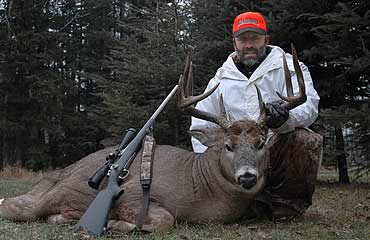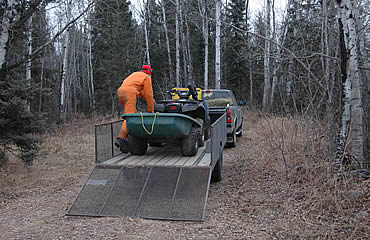Sometimes you have only seconds to choose whether or not to shoot. Here’s some help on how to decide.
Whoa! Where’d he come from?” I didn’t remember looking away, but I must have because a very large buck now stood where seconds earlier the space was empty.
“Shooter.” The word popped into my head. I knew it. I might have even said it aloud, for the buck turned and glared at me the way they do before they’re about to bolt.
Frantically, I fumbled for my rifle, propped it on the shooting rest, put my cheek to the cold synthetic stock of my custom Model 7 XCR and found the deer in my scope. “Stop,” I told myself. “Don’t be hasty.”
I had three good reasons not to be. The first was buck fever. Thirty-plus years of chasing whitetails, and I still get that intense adrenaline rush whenever I see a buck. Over time, it’s gotten better, but to this day I occasionally whiff because I don’t take that extra second to settle my nerves before jerking the trigger — another bad habit. Forcing myself to gain control also gave me a chance to realize the deer wasn’t going anywhere … yet.
There was no need to be hasty, despite what experience had taught me. My philosophy has long been: “Take the first clean shot opportunity you get, for it very likely could be the only one.” It has become instinctual, born out of hunting extremely pressured deer on public land. If and when you saw a good buck, or any buck for that matter, you had to react quickly. Hesitate even for a fraction of a second, and your deer would be gone. But this wasn’t public land, and these deer weren’t pressured. “Be patient,” I instructed myself.
 Then there was the minimum. Ugh. During our orientation the previous day, outfitter Susan Schigol was going over the camp rules. “We have a 150-inch minimum,” she said. The words hit me like a bucket of ice water. “Whaahaaa?” I thought, somehow managing to keep my jaw from dropping to the floor and my eyes from bugging out of my head. Had anyone bothered to look, they would have recognized the panic on my face.
Then there was the minimum. Ugh. During our orientation the previous day, outfitter Susan Schigol was going over the camp rules. “We have a 150-inch minimum,” she said. The words hit me like a bucket of ice water. “Whaahaaa?” I thought, somehow managing to keep my jaw from dropping to the floor and my eyes from bugging out of my head. Had anyone bothered to look, they would have recognized the panic on my face.
“Just my luck,” the thoughts rolled. “Here I am in Saskatchewan, land of the giants, a place where there is a legitimate chance of shooting a 150-plus buck. But it’s also nice to know that if one doesn’t show up, I can ‘settle’ for a 140 at week’s end — a little insurance policy.” No, not this time. I doubt it would have changed my mind about going there. Still, it would have been nice to know ahead of time.
When you put everything into perspective, my dilemma wasn’t so bad. For starters, I was in Saskatchewan, the land of deer hunting dreams, where really, really big bucks roam. According to the biological principle known as Bergman’s Rule, “Warm-blooded animals living in cold climates tend to be larger than animals of the same species living in warm climates.” November temperatures in Saskatchewan typically run in the single digits or even below zero, and a mature buck weighing 350 pounds on the hoof is not unusual.
That 150 minimum seemed particularly unreasonable at first, but it, too, had an upside. Wayne and Susan Schigol, who run Great Grey Outfitters near Meath Park, have exclusive hunting rights to a large area. That allows them to control the number and size of bucks taken. Hunting pressure is light, so they’re not overshooting. And with a 150-inch minimum, they ensure there will always be a bounty of mature bucks. This year’s “non-shooter” in the mid-140s will be next year’s 150. The 150s that elude this year’s hunters will be next year’s 160s. And yes, there are 160-class bucks taken every year at Great Grey.
Trading riflescope for the Nikon Premier 10x42s, I asked myself, “Is he mature?” I hadn’t expected the minimum, but I knew I’d be looking for a mature buck, so I’d studied the distinguishing characteristics. First I looked for a neck that blended seamlessly into his shoulders. This buck had no neck, just shoulders extending to his head. If deer could play football, this one would have been a lineman. “What about the rest of the body?” I thought. “Does it have that characteristic strong but sleek racehorse look of a 3 1/2-year-old? Nope. He looks more like a steer.”
 I could clearly see the point where the bottom of its belly line met its rear legs. It was a straight line, with no upturn toward the groin. This was certainly a mature buck. The adrenaline started to rise again, and my trigger finger started to twitch, but there was the unexpected minimum looming.
I could clearly see the point where the bottom of its belly line met its rear legs. It was a straight line, with no upturn toward the groin. This was certainly a mature buck. The adrenaline started to rise again, and my trigger finger started to twitch, but there was the unexpected minimum looming.
Thanks to years of experience hunting and scoring whitetails, I knew what to look for there as well. At least 10 points? Check. Good mass? Main beams past its ears, and with bases bigger around than its eyes? Check, and check. P2s at least 10 inches long? Check. “Okay, I’m pretty sure he’ll make it, but it’s only the first day.”
That only muddied the waters. My previous two trips to Saskatchewan were eerily similar: Shooter bucks tempted me within the first hour of both hunts. It wasn’t easy, but I passed up the shots. Then, for two more days, I saw nothing even remotely close to a mature buck. In both cases, the first-day shooter finally reappeared late in the week and came home with me. Could I count on that kind of luck a third time if I saw nothing bigger? Would this buck give me a second chance? Or, would I sit for days, possibly in sub-zero temperatures, ruing my decision if I let him walk?
This buck was noticeably bigger than the other two. “Never pass up a buck on the first day that you’d shoot on the last day.” If I had a dollar for every time an outfitter or another hunter in camp told me that, I’d retire from my “real job” and hunt for a living.
I lifted my binoculars one more time and studied its chocolate-brown rack and deep chest. My mind switched back and forth between images of sitting for hours in bone-chilling temperatures with the hope a bigger buck might come, and hours of contented boredom back at camp, placated with a successful, albeit brief, hunt.
It’s amazing how fast the mind works. In the time it took you to read the last paragraph, everything else you read before that flashed through my mind. It took a minute, maybe two to weigh all the variables, consider the options, size up the deer; then seconds to make the decision. I settled the crosshairs on the buck’s vitals and my mind went blank. Conscious thought ceased and instinct took over. A moment later, the buck lay still.
Field-Judging Whitetails
Most Saskatchewan outfitters have minimums for their bucks, which in most cases means being able to tell the difference between 3 1/2- and 4 1/2-year-old (and older) bucks. The younger buck might, at first glance, appear mature. It often will carry a big rack and be thickly muscled, with the appearance of a well-conditioned racehorse. Once a deer reaches 4, it stops growing, and surplus energy goes to body and antler mass. It, too, will look muscular, but less like a horse and more like a bull. In particular, look at the following features:
A thickly muscled neck
3 1/2: distinct junction between neck and shoulders
4 1/2: neck blends into shoulders
Waistline
3 1/2: narrower, so chest appears deeper
4 1/2: forms a straight line as deep as chest
Antler Spread
Tip-to-tip distance between an adult buck’s ears in a relaxed or semi-alert position is approximately 15 inches (16 in a northern buck). Look for antler spread outside the ears.
Beam Length
Beam length is highly variable, and rack shapes can vary considerably. However, looking at a buck’s profile, a mature buck’s beams should generally extend beyond the eye (16 inches), and often to the tip of the nose (20 inches).
Beam Thickness
Look at the bases. On a mature buck, they will be as thick as, or often thicker than, the diameter of the eyes. Also look for how far that mass is carried along the beam length.
Tines
Number of points is a poor indicator of age, but the more the better. Anything less than 10 should be looked over very carefully. Also look at tine length. Some things that will help your score include brow tines of 6 inches or more (compare to ear length) and P2s of 10 inches or more. Next, compare the P3s and P4s.
Read Recent Articles: • Counting Points: Do state-mandated antler restrictions make a positive impact on herd health?
• No Second Thoughts: Some say taking an albino deer is bad luck, but this hunter didn’t even think twice.
• In Need of an Intervention: Self-confessed deer hunting addict finally gets the trophy of her dreams.
This article was published in the November 2008 edition of Buckmasters Whitetail Magazine. Join today to have Buckmasters delivered to your home.